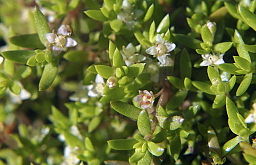 |
New Zealand pigmyweed | Status LU: established. 1st record: LU & ITW 2020. |
 |
Weier-Déckblat | Status Eur.: established. 1st record: UK 1911. |
 |
Crassule des étangs | RA: ISEIA: B1 – Watch List. Harmonia+: 0,44 |
 |
Nadelkraut | Wikipedia:    | Wikispecies: | Wikispecies:  | CABI | CABI |
 |
Watercrassula | Back to the list of neophytes |
Contents
Report the species
→ Report Crassula helmsii to the National Museum of Natural History.
Brief description
Crassula helmsii (Kirk) Cockayne, native to New Zealand and Australia, is an aquatic or semi-terrestrial plant that colonises a wide variety of freshwater habitats. The plant’s ability to grow from stem fragments enables it to easily spread from ponds and ornamental pools into the wild. Waterfowl, mammals, downstream movement and flooding all play an important role in plant dissemination. New Zealand pigmyweed can cause major environmental problems in freshwater habitats. It forms dense vegetation mats that deplete oxygen, outcompete native species and may affect the breeding success and survival of threatened aquatic plants and amphibians. Mats choke ponds and drainage ditches, impede water flow and adversely affect recreational activities. In rivers, flow behaviour may change when the plant occurs in masses (Branquart et al. 2013).
Status and distribution in Luxembourg
Records of Crassula helmsii (Kirk) Cockayne in Luxembourg. Data source: Recorder-Lux, iNaturalist & GBIF, 2025-12-19.
First reported in Belgium in 1983, this species experienced a strong expansion about 15 years later and will probably be found in other parts of the territory of the Flora. The plant is highly variable depending on whether it grows in water (aquatic phenotype) or on the banks of more or less dry ponds (terrestrial phenotype) (Lambinon & Verloove 2012).
Management
Our neighbouring countries have already gained experience with the management of the species and made it available in publications: Dortel & Dutartre 2018, Delbart et al. 2011, Ewald 2014, van der Loop et al. 2018.
Risk assessment
ISEIA protocol
Following its discovery in Luxembourg in July 2020, the species has been reassessed on 24 July 2020 to B1 (2+3+2+3) = Watch List by Christian Ries and Yves Krippel. Assessment before the appearance of the species in Luxembourg: B0 (2+3+2+3) = Alert List (Ries et al. 2013: 18).
Harmonia+ protocol
Overall risk score 0,44 = (Overall Invasion score 0,76 x Overall Impact score 0,57) (Ries et al. 2020).
 Invasion
Invasion0,57

 Impact
Impact0,44

 Risk
RiskWorldwide distribution
Bibliography
- Branquart, E., I. Stiers, L. Triest, S. Vanderhoeven, W. Van Landuyt, F. Van Rossum & F. Verloove, 2013. Harmonia database: . Harmonia version 1.2, Belgian Forum on Invasive Species. URL: http://ias.biodiversity.be [accessed on 2020-02-28]
- CABI, 2019. Crassula helmsii. In: Invasive Species Compendium. Wallingford, UK: CAB International. URL: www.cabi.org/isc [accessed 2020-02-28]
- Dortel, F. & A. Dutartre, 2018. La Crassule de Helms (Crassula helmsii Cockayne, 1907) : Fiche d’alerte détaillée, première analyse des risques, possibilités de régulation et mesures de biosécurité. 23 p. [PDF]
- Delbart, E., A. Monty & G. Mahy, 2011. Gestion de Crassula helmsii en Belgique plus difficile qu’il n’y paraı̂t? Bulletin OEPP/EPPO Bulletin 41: 226–231. [PDF]
- Ewald, N.C., 2014. Crassula helmsii in the New Forest – a report on the status, spread and impact of this non-native invasive plant, and the efficacy of novel control techniques following a 2 year trial. Partner Annex Report for RINSE prepared on behalf of the New Forest Non-Native Plants Project. Freshwater Habitats Trust, Oxford. [PDF]
- Lambinon J. & F. Verloove, 2012. Nouvelle flore de la Belgique, du grand-duché de Luxembourg, du Nord de la France et des régions voisines. Sixième édition. Avec la collaboration de L. Delvosalle, B. Toussaint, D. Geerinck, I. Hoste, F. Van Rossum, B. Cornier, R. Schumacker, A. Vanderpoorten et H. Vannerom. Jardin botanique national de Belgique, Meise. CXXXIX + 1195 pp. ISBN : 9789072619884.
- MNHNL, 2000-. Recorder-Lux, database on the natural heritage of the Grand Duchy of Luxembourg. National Museum of Natural History, Luxembourg. Crassula helmsii (Kirk) Cockayne observed on 2020-07-23, occurrence ID MNHNL00000005TLE, via https://mdata.mnhn.lu [accessed 2021-02-22].
- MNHNL, iNaturalist & GBIF, 2020. in MNHNL-mdata, online portal combining species observation from Recorder-Lux, iNaturalist and GBIF. National Museum of Natural History, Luxembourg. URL: https://mdata.mnhn.lu [Accessed 2020-02-28]
- Oly, M., 2022. Kartierung invasiver gebietsfremder Wasserpflanzen im Großherzotum Luxemburg, Untersuchungen zur Verbreitung von invasiven gebietsfremden Wasserpflanzen in einer beispielhaften Auswahl an Stillgewässern, Musée national d’histoire naturelle, Luxembourg. 117 pp.
- Ries, C. & Y. Krippel, 2021. First records of 56 invasive alien vascular plants in Luxembourg. Bulletin de la Société des naturalistes luxembourgeois 123: 115-127. [PDF 241 KB]
- Ries, C., Y. Krippel & M. Pfeiffenschneider, 2020. Risk assessment after the Harmonia+ protocol of invasive alien vascular plant species in Luxembourg. Bull. Soc. Nat. luxemb. 122: 197-205. [PDF 132 KB]
- Ries, C., Y. Krippel, M. Pfeiffenschneider & S. Schneider, 2013. Environmental impact assessment and black, watch and alert list classification after the ISEIA Protocol of non-native vascular plant species in Luxembourg. Bull. Soc. Nat. luxemb. 114: 15-21. [PDF 652 KB]
- van der Loop, J.M.M., L. de Hoop, H.H. van Kleef & R.S.E.W. Leuven, 2018. Effectiveness of eradication measures for the invasive Australian swamp stonecrop Crassula helmsii. Management of Biological Invasions (2018) Volume 9, Issue 3: 343–355. DOI: https://doi.org/10.3391/mbi.2018.9.3.16 [PDF]
- Wolff, J.-P., 2020. Crassula helmsii observation at iNaturalist. URL: https://www.inaturalist.org/observations/54040409 [accessed 2020.07.24].
Suggested citation of this webpage
Ries, C., M. Pfeiffenschneider & Y. Krippel (Eds.), 2025. Crassula helmsii (Kirk) Cockayne. In: neobiota.lu - Invasive Alien Species in Luxembourg. National Museum of Natural History, Luxembourg. URL: https://neobiota.lu/crassula-helmsii/ [Accessed 2025-12-19].
Page content last updated on 2025-10-02.





